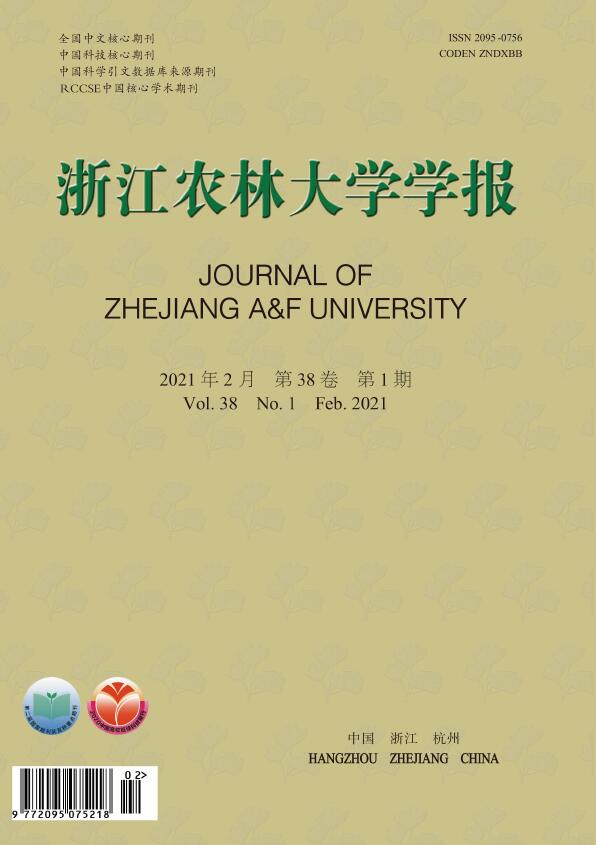-
筛胸梳爪叩甲Melanotus cribricollis属于鞘翅目Coleoptera叩甲科Elalerirdae,在世界各地均有分布[1-2]。其食性杂,寄主植物种类繁多,危害范围较广[3],在中国北方主要危害水稻Oryza sativa、玉米Zea mays、蔬菜等经济作物[4],在中国南方,是竹林笋期主要的害虫之一[5]。竹子是具有经济、生态和社会效益的重要林种,在中国林业经济发展中占据重要地位[6],但随着对竹林的开发力度加大,以及竹林地覆盖经营技术的推广,在笋期以筛胸梳爪叩甲为主的地下害虫危害也变得愈发严重[7]。筛胸梳爪叩甲幼虫主要取食鞭笋、鞭根等部位,造成了虫笋和退笋,严重影响竹制品的产量和商品价值,加剧了竹林地衰败[5,8]。根据报道,在浙江安吉竹博园47个竹种中,有41个竹种都受到了筛胸梳爪叩甲的危害;而在德清县,筛胸梳爪叩甲发生面积超过2 000 hm2,年损失达千万元[9-10]。由于筛胸梳爪叩甲幼虫阶段长时间在地下,危害时间久、隐蔽性强,并且在土壤的活动深度随着环境变化而变化,因此,目前筛胸梳爪叩甲的防治和监测是林业工作的难点[11]。国内外均对筛胸梳爪叩甲防治开展研究,并提出了如水淹耕地[12]、灯光诱杀的物理防治,作物轮作[13]的林地管理,以及农药拌种[14-15]、毒饵诱杀[16]及信息素诱捕[17-19]等生物化学防治方法等。其中,以化学防治最多,且效果最好。欧美等国早期曾使用过林丹、艾氏剂等有机氯农药防治筛胸梳爪叩甲,在种植前喷施及结合肥料施用,都取得了一定防效[20]。随后,有机磷农药如甲拌磷、地虫磷及呋喃丹也被用于筛胸梳爪叩甲防治,且取得了不错的效果[21]。也有研究发现氟氯氰菊酯、吡虫啉、油茶饼、白僵菌以及苏云金杆菌等农药对筛胸梳爪叩甲具有一定的防治效果,但氟氯氰菊酯、吡虫啉等防治效果并不稳定[11]。此外,部分植物提取物制剂,如噻虫嗪、印楝素等也有应用于筛胸梳爪叩甲防治的报道[22]。由于竹林系统的特殊性,使得农业上筛胸梳爪叩甲的防治与竹林上的防治手段存在较大区别,竹林筛胸梳爪叩甲防治目前未取得明显效果[10,23]。同时由于部分化学药剂不易分解、毒性大,给竹类产品和环境安全带来巨大挑战。因此,本研究对目前市场上普遍应用的几种化学杀虫剂进行测试和评价,以期为防治筛胸梳爪叩甲这种竹林重大地下害虫提供技术指导。
HTML
-
虫源采集自浙江省杭州市临安区太湖源镇雷竹Phyllostachys violascens笋产区,挑选6龄期,体色、大小、健康状态基本一致的筛胸梳爪叩甲幼虫,带回实验室在室内温度24 ℃,相对湿度50%~60%的自然光照环境下继续饲养。将筛胸梳爪叩甲幼虫放置在切开的新鲜雷竹笋上,并倒扣置于养虫盒中的竹林土壤表面,同时用少量土壤覆盖竹笋。养虫盒(24 cm×11 cm×4 cm)底部铺有1层1 cm厚的细沙,顶部用纱网覆盖。每个养虫盒饲养20~30头幼虫,每日更换新鲜雷竹笋,每隔1 d喷洒少量清水。
-
质量分数为0.5%氟虫腈粉剂(江苏功成生物科技有限公司),分别配置成质量分数为0.200 0、0.400 0、0.800 0、1.600 0、3.200 0 g·kg−1药剂;质量分数为5.0%辛硫磷颗粒剂(瑞隆化工有限公司),分别配置成质量分数为0.037 5、0.075 0、0.200 0、0.400 0、0.800 0 g·kg−1药剂;质量分数为20.0%氯虫苯甲酰胺悬浮剂(富美实康宽公司),分别配置成0.625 0、1.250 0、2.500 0、5.000 0、10.000 0 g·kg−1药剂。
-
采用拌土法,将质地均匀的竹林土壤和砂子按照2∶1的体积比均匀混合后,通过60目筛网进行筛选,去除石块等异物,并对混合土壤进行消毒。每个塑料盆(24 cm×11 cm×4 cm)装入无菌混合土壤750 g,再加入100 g新鲜竹笋作为食物来源。在温度24~26 ℃、湿度60%的室内环境中,将待测药剂搅拌进土壤中,随后喷洒清水,使土壤湿度保持在15%~18%。使用清水为空白对照,每处理设置3个重复,每个重复10头幼虫。24 h后观察筛胸梳爪叩甲的死亡情况(包括僵直死亡、腐烂死亡等),并记录其死亡率。对照组死亡率超过20%时,则视为无效。
-
利用SPSS软件计算毒力测定回归方程、致死中质量分数(LC50)、致死95%质量分数(LC95)、相关系数r2等。
1.1. 材料
1.1.1. 虫源
1.1.2. 药剂
1.2. 方法
1.3. 数据处理与统计分析
-
筛胸梳爪叩甲经供试杀虫剂处理24 h后,防治效果不均。从表1可知:3种药剂对筛胸梳爪叩甲致死效果的药效从大到小依次为5.0%辛硫磷、0.5%氟虫腈、20.0%氯虫苯甲酰胺。这3种药剂在相同或相近质量分数下,致死效果差异较大。5.0%辛硫磷在质量分数为0.800 0 g·kg−1时,校正死亡率为100%;0.5%氟虫腈在质量分数为0.800 0 g·kg−1时,校正死亡率为53.85%;而20.0%氯虫苯甲酰胺在质量分数为0.625 0 g·kg−1时,校正死亡率仅为7.69%。因此,3种药剂中5.0%辛硫磷对筛胸梳爪叩甲的致死效果最好。
药剂 质量分数/
(g·kg−1)死亡率/% 校正死亡率/% 5.0%辛硫磷 0.037 5 14.29±1.33 7.69±1.43 0.0750 14.29±0.28 7.69±0.31 0.200 0 42.86±1.56 38.46±1.67 0.400 0 71.43±1.53 69.23±1.68 0.600 0 85.71±2.57 84.62±2.76 0.800 0 100.00±0.00 100.00±0.00 0.5%氟虫氰 0.100 0 14.29±0.50 7.69±0.54 0.200 0 14.29±0.41 7.69±0.44 0.400 0 28.57±1.08 23.08±1.16 0.800 0 57.14±0.85 53.85±0.91 1.600 0 42.86±2.07 38.46±2.23 3.200 0 85.71±1.45 84.62±1.56 20.0%氯虫
苯甲酰胺0.625 0 14.29±0.47 7.69±0.50 1.250 0 28.57±0.78 23.08±0.84 2.500 0 42.86±0.61 38.46±0.65 5.000 0 57.14±1.23 53.85±1.33 10.000 0 100.00±0.00 100.00±0.00 Table 1. Mortality of M. cribricollis at 24 h at different concentrations of pesticides
-
由表2可知:筛胸梳爪叩甲经不同质量分数药剂处理24 h后,5.0%辛硫磷LC50为0.19 g·kg−1,0.5%氟虫腈LC50为0.95 g·kg−1,20.0%氯虫苯甲酰胺LC50为1.82 g·kg−1。结果显示:5.0%辛硫磷毒力最大,活性较好,更具选择性,因此更适用于竹林中筛胸梳爪叩甲的防治。
药剂 毒力回归
方程LC50/
(g·kg−1)LC95/
(g·kg−1)相关
系数5.0%辛硫磷 y=2.453+2.275x 0.19 1.09 0.95 0.5%氟虫腈 y=0.031+1.308x 0.95 17.11 0.78 20.0%氯虫苯
甲酰胺y=−2.89+1.019x 1.82 79.07 0.99 Table 2. Test results of insecticide toxicity on M. cribricollis
2.1. 药剂对筛胸梳爪叩甲的致死效果
2.2. 药剂对筛胸梳爪叩甲的毒力测定
-
本研究采用拌土法,通过室内试验对3种化学药剂对筛胸梳爪叩甲毒力进行测定。拌土法是筛胸梳爪叩甲毒力测定采用较多的方法[11,24],与林间的实际情况接近,相当于小型的林间试验[7]。本研究表明:3种农药中5.0%辛硫磷颗粒剂效果最好,其次为0.5%氟虫腈粉剂,20.0%氯虫苯甲酰胺悬浮剂效果最差。这样的结果与已有报道[11,25-26]中0.1%氟虫腈效果好于3.0%辛硫磷的结果并不相同,这可能是由于农药的有效含量不同引起的差异。此外,有研究表明:药剂的剂型对防效也有一定的影响[10],这也可能是5.0%辛硫磷颗粒剂毒力效果较好的重要原因。颗粒剂型防效较乳油等其他剂型更为明显,这可能是由于颗粒剂型具缓释作用,较其他剂型具有更长持效性,防治效果更好。因此,在施药方法上,可将药剂制成颗粒剂按深度撒施在竹鞭周围,同时施药后及时翻土,并在雨前施药,加速药剂渗入土壤,以达到更好的药效。施药时间也是影响药效的重要因素。研究表明:连续3 a施用质量分数为3.0%毒死蜱+5.0%辛硫磷颗粒剂才达到满意的防治效果[10]。
在毒性方面,0.5%氟虫腈粉剂和20.0%氯虫苯甲酰胺悬浮剂都是微毒,而5.0%辛硫磷颗粒剂为低毒,相对另外2种化学杀虫剂毒性稍高;在防治成本方面,5.0%辛硫磷颗粒剂防治成本为750~1 500元·hm−2,而0.5%氟虫腈粉剂和20.0%氯虫本甲酰胺悬浮剂防治成本分别为1 500~3 000和4 500~9 000元·hm−2。因此,根据防效、毒性和防治成本等因素综合考虑,5.0%辛硫磷颗粒剂和0.5%氟虫腈粉剂适合用于防治筛胸梳爪叩甲。
在防治过程中,可针对不同时期的筛胸梳爪叩甲采取不同的防治手段。在幼虫阶段,可利用幼虫对二氧化碳、鲜嫩草及羊粪有明显趋向性的特点与化学药剂防治相结合,将发芽种子或经杀虫剂浸染的杂草作为诱杀筛胸梳爪叩甲的重要手段[13,16,27]。而在成虫期间可利用灯光诱捕、信息素诱捕等方法与化学药剂结合的方式实现筛胸梳爪叩甲防治。









 DownLoad:
DownLoad: